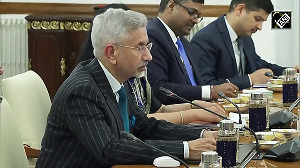The decision to do away with Rs 500 and Rs 1,000 notes accelerated the slowdown in economic activity with growth averaging 6.8 per cent in the seven quarters after it, as against an average of 8 per cent in the six quarters preceding it, says former chief economic advisor Arvind Subramanian.

A few months after announcing his resignation from the post of chief economic advisor, Arvind Subramanian is now candid on controversial issues such as demonetisation, which he had eschewed during his stint.
“Demonetisation was a massive, draconian, monetary shock. It was an unprecedented move that no country in recent history had made in normal times,” he notes in his new book.
The decision to do away with Rs 500 and Rs 1,000 notes accelerated the slowdown in economic activity with growth averaging 6.8 per cent in the seven quarters after it, as against an average of 8 per cent in the six quarters preceding it, Subramanian notes.
Though the move severely impacted the informal sector, it was puzzling on two counts - first, that it did not have a bigger impact on growth and second, that the move turned out to be an electoral winner in the Uttar Pradesh elections in 2017, says the former CEA.
In addition to demonetisation, Subramanian addresses a range of issues such the implementation of the goods and services tax (GST), the twin balance sheet problem, the problems facing the Indian agriculture in his new book titled “Of Counsel: The Challenges of the Modi-Jaitley Economy”, published by Penguin.
The former CEA also wades into the ongoing rift between the central government and the Reserve bank of India (RBI).
Subramanian, who was one of the first to propose a transfer from the RBI to the central government, notes that the central bank has excess capital of Rs 4.5 trillion if one was to apply a risk tolerance of 1 per cent over time.
His own estimate was that the bank is holding excess capital to the tune of Rs 4.5-7 trillion, which he argues could be used to recapitalise public sector banks.
On the surge in non-performing assets (NPAs) over the past few years, Subramanian notes that the “RBI had also been aware of the mounting problem in the early 2010s”.
“To a certain extent this situation occurred because a series of RBI initiatives allowed a form of ‘extend and pretend’, postponing repayments to a day of reckoning far in the future,” he adds.
He chastises the RBI for not being able to “grasp the seriousness of the loan repayment problems or identify the prolonged frauds of Nirav Modi,” and says, “That it has a good reputation, however, does not mean it is always right”.
Though of the flip side, he sides with the RBI on issues of Prompt Corrective Action framework (PCA) and the power of the RBI to deal with public sector banks.
“RBI deserves credit for maintaining the integrity” of the Prompt Corrective Action (PCA) process “amidst pressures from the government to dilute it” he notes, adding that “when dealing with errant public-sector banks, the RBI needs additional powers so that it can meaningfully sanction the banks.
"For example, the RBI should be able to remove board members, convene a meeting of the board, or supersede the board of public sector banks, just as it can with private-sector banks.”
Subramanian believes that the government’s cautious approach to the problem of NPAs in the initial years was due to a combination of reasons.
With economic growth accelerating, it created “the impression that the problem would solve itself.
It also provoked the question of ‘how serious can the problem be if growth is so good'?
Moreover, being in fiscal consolidation mode, the government felt it did not have the resources to fill the gap that would have been left in the banks if the problem of the NPAs had been fully recognized and tackled.
The accusation of ‘suit-boot ki sarkar’ is also likely to have compounded the problem.
“The perceived differential treatment of indebted fat cats (corporates) versus debt-burdened poor farmers, and the fear that decisions by public-sector bank managers would be the object of investigation by the 4Cs made the writing down or writing off of loans - absolutely vital to any solution - virtually impossible.”
And while he hails the Insolvency and Bankruptcy Code (IBC) as a potentially transformational reform, Subramanian is skeptical about its effectiveness.
“At the current rate of disposal of cases by the National Company Law Tribunal (NCLT), it could take another five to six years for the most important cases to be settled,” he says.
He also calls on the RBI to modify the February 2018 circular “to allow for departures from the IBC process in the case of power-sector assets and smaller loans.”
On GST, Subramanian notes that Hasmukh Adhia and state finance ministers such as Manish Sisodia wanted to include land and real estate in the GST system.
“But the reform effort was soon buried by vehement opposition, including from some of the large, BJP-led states such as Gujarat and Maharashtra,” he notes.
Photograph: Adnan Abidi/Reuters











